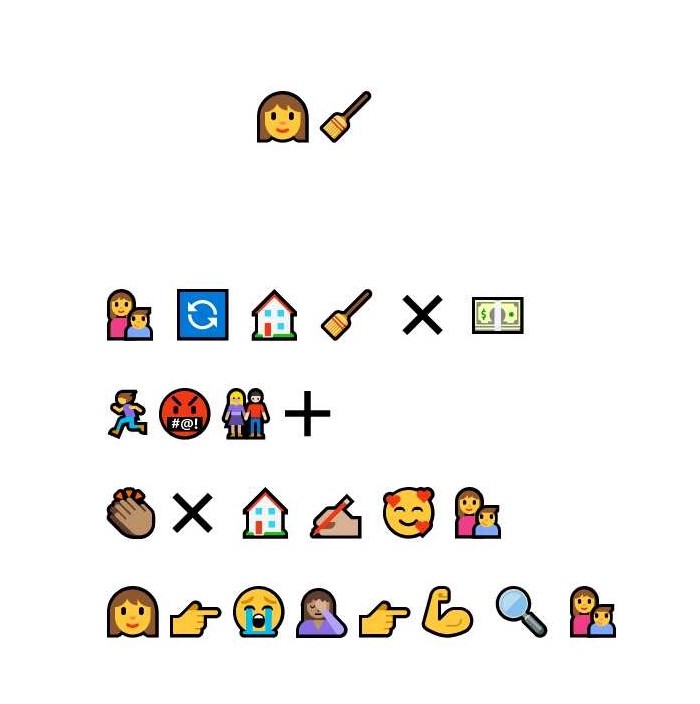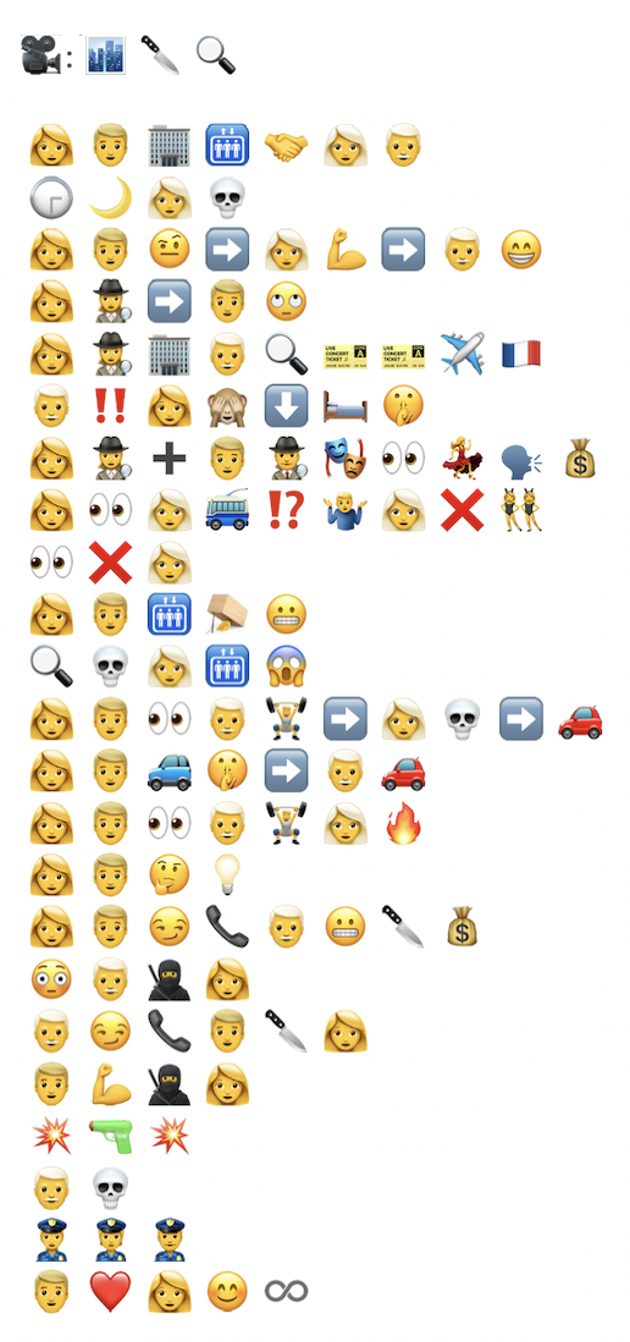Link 4 – Analesa Crookes-Eadie’s Task 6 (An Emoji Story)
My Task 6 link.
I am not entirely sure, but my guess is that Analesa’s emojis represent the Netflix short series ‘Maid’. I have not seen it myself, but from the trailer I have seen and the emojis Analesa chose for the title, I think I might be on the right track.
 At a quick glance, although I notice some differences between Analesa’s and my emoji stories, I do notice some similarities as well. Both of our titles are short and simple, however, Analesa’s title is a representation of the character whereas my title emojis represent the three individual words of the title. We both wrote out our stories from left to write. This is another confirmation of what Kress (2005) said about order being fixed. As I stated in my task, although emoji order cannot (most of the time) mimic the syntax in a sentence, we can mimic the order of chapters, pages, and lines (Kress, 2005). Analesa remarked how the lack of punctuation marks was challenging, but I agree that, somehow, the change in lines kind of acted as a marker for the next ‘sentence.’
At a quick glance, although I notice some differences between Analesa’s and my emoji stories, I do notice some similarities as well. Both of our titles are short and simple, however, Analesa’s title is a representation of the character whereas my title emojis represent the three individual words of the title. We both wrote out our stories from left to write. This is another confirmation of what Kress (2005) said about order being fixed. As I stated in my task, although emoji order cannot (most of the time) mimic the syntax in a sentence, we can mimic the order of chapters, pages, and lines (Kress, 2005). Analesa remarked how the lack of punctuation marks was challenging, but I agree that, somehow, the change in lines kind of acted as a marker for the next ‘sentence.’
 Another big difference is that I strangely tried to write out the entire plot of my movie, whereas Analesa gave a brief overview of the storyline. I like this idea better as I believe that this emoji activity becomes too complicated when there are too many emojis to interpret.
Another big difference is that I strangely tried to write out the entire plot of my movie, whereas Analesa gave a brief overview of the storyline. I like this idea better as I believe that this emoji activity becomes too complicated when there are too many emojis to interpret.
Analesa said that, initially, they wrote the plot out on paper and then tried to fill it in with emojis. I did not have that same initial thought as I just tried to go through the movie in my mind and select the pictures that fit the storyline the best. I do agree, however, that, as Analesa explained, “one emoji can represent two or more words and sometimes a phrase or a sentence.” This can complicate things as no one can predict exactly how the emojis will be interpreted. As individual words, as an expression, as a theme, etc.
When I initially completed this task, I agreed with what Analesa said about Emojis creating their own slang that not everyone can understand. Analesa went on to say that, for some people, emojis confuse reading and writing due to their many different interpretations. Bolter (2001) agreed that, although images can express meaning, they lack the ability to share information that does not allow for different interpretations. With text you can work on making things explicit, but this is more complicated with emojis as their meaning is not necessarily clear (Kress, 2005).
Although I agree that emojis can be interpreted in different ways depending on culture, age, etc., I also do think that emojis can enhance written texts to improve understanding as well. There is the obvious expression of emotions, but even when it comes to understanding the vocabulary in a new language, or emphasizing certain parts of the text, we can greatly enhance a text with emojis. There are also some situations where different interpretations are welcome, like when interpreting art, or creating something unique.
Analesa has a nice blog space that is easy to navigate. I have one set photo at the top of every page, but I like that Analesa has a set background. It is simple to get from the weekly tasks to the linking and final assignments. I especially like the setup of the weekly tasks as it is simple to get a clear overview of all of them. Finally, I like how at the bottom of the page, there’s the comment section, post information, and author information. I feel like the choice of theme for Analesa’s blog was well selected. My blog, although it offers navigation buttons, aesthetically it is harder for users to get around and see everything clearly.
References:
Bolter, J.D. (2001). The breakout of the visual. In Writing spaces: Computers, hypertext, and the remediation of print (2nd ed., pp. 47-76). Lawrence Erlbaum Associates. https://doi.org/10.4324/9781410600110
Kress, G. (2005). Gains and losses: New forms of texts, knowledge, and learning. Computers and Composition, 22(1), pp. 5-22. https://doi.org/10.1016/j.compcom.2004.12.004